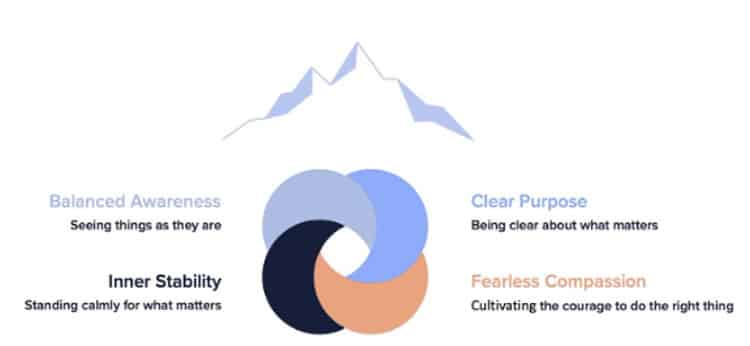Leader, Command Thyself

In an uncertain world, a leader’s most valuable asset is the capacity to face each day with awareness, clarity, and the courage to do the right thing.
As a leader, what do you bring to the people you lead?
This is a question I often ask senior leaders. Rarely does anyone have a clear answer.
Do you?
Leadership is all about impact. If you’re not clear about the impact you want to make, you won’t be able to make it.
In all the leaders I’ve known, what distinguishes the good from the great is their capacity to show up – i.e. be present – in a way that feels natural and generates positive impact.
Those leaders know how to quieten all the voices in their head except for their own true voice. They possess a kind of inner space, like a ‘safe haven’, akin to a state of inner peace. They are at one with themselves.
Pause for a moment. Have both feet on the ground. Tune into your breath. Bring your attention to the area between your heart and your gut. Place your hand there. Breathe consciously – slowly, deeply – into your hand for at least three breaths.
Now gently ask yourself this:
How am I present for the people I lead and love?
“At one with yourself” is possibly the toughest thing to be. We all carry our own burdens, and society does little to lighten the load. Some acknowledged great leaders of the past – like Nelson Mandela, Mahatma Gandhi, or Mother Theresa – may well seem to have been at one with themselves. But I doubt they always were. All of them were human, just like us. They had their struggles too.
So, if being at one with yourself is a desirable quality in a senior leader, how do you cultivate it?
Introducing Mindful Command
Mindful Command is both a concept and a highly practical set of tools and practices for building your inner capacity to align who you are with how you lead. When you think and act with Mindful Command, you are aware, clear, grounded, stable, and not afraid to speak and act for what is right. These are qualities which every one of us can evolve within ourselves.
The unusual juxtaposition of apparently contradictory ideas – mindful and command – stems from my own experience of how well they work together.
- Command. As an ex-Royal Navy Commander, I have first-hand experience of the military concepts of commander’s intent and mission ‘command’. Commander’s intent is a leader’s clear statement of the desired outcome of an operation, including its purpose, objectives and the resources required. Mission command combines the commander’s intent with delegated freedom of action, initiative, responsiveness, and flexibility. The why and the what are clarified up front, and the people responsible for its execution are empowered to decide on the how.
- Mindful. This is a quality of awareness, presence, and impact that develops with mindfulness practice.
There’s nothing military or directive about Mindful Command. Separately, mission command and mindfulness stand alone. Together, they help you cultivate the capacity to show up, whatever the circumstance, as your calm, centred self, confident of doing the right thing.
Ultimately, Mindful Command is a holistic foundation for skilful leadership, represented simply here:

Balanced awareness amplifies clear purpose; clear purpose fuels fearless compassion; fearless compassion channels balanced awareness and clear purpose into action; inner stability enables them all to evolve.
Together, they develop your capacity to pause and create an inner space to listen, speak, and act with integrity.
Mindful Command in practice
One of the best leaders I’ve ever worked with, Admiral Sandy Woodward, once told me a story, from Cold War days, about a very difficult challenge he faced when taking command of the nuclear-powered submarine HMS Warspite. The tale of clear, courageous, compassionate leadership is as relevant now as it was then.
It’s 1969. One year earlier, Warspite had been involved in an underwater collision with a Soviet submarine in the Barents Sea. The vessel had been knocked over under water to an angle of almost 75 degrees, had swung back like a pendulum, hit the other vessel a second time and been knocked over again.
The submarine had now been repaired but not yet tested. Many of the crew were still shaken by the incident and had lost confidence in the boat’s capability and safety.
Calmly and without fuss, Woodward took the submarine and its crew into a training exercise which included a series of extreme underwater manoeuvres, emergency dives and surfacings. These culminated in a very steep and rapid dive which took the submarine to the limit of its safe diving depth before pulling out.
This was a calculated risk, but not a gamble. In leadership this is a critical distinction. Woodward saw that what mattered most was gaining the complete confidence of his crew. He judged that nothing less than a comprehensive demonstration of the submarine’s capability would achieve it. He understood the risks and had the necessary technical knowledge and skills to minimise them. He also understood what his people were capable of, even if they themselves doubted it. He was prepared to take them to the edge of fear, confident he could bring them back. He made a difficult choice, for the right reasons, and he had the courage to execute it.
Ultimately, the leader’s job is to confront the difficult challenge and make the right decision. They must understand all aspects of the task at hand and properly consider the people involved. The higher the stakes, and the greater the risk, the sharper their focus needs to be on what matters and what action is necessary to achieve it. They must also accept that mistakes will occur and be ready to course correct. In other words, the leader’s job is to roll strategy, tactics, and the welfare of their people into one.
This is Mindful Command in action: a balanced awareness of what is at stake for you, others, and the context; a clear view of what is needed; and the courage to do the right thing. All supported by a sense of inner stability that comes from learning how to be at one with yourself.
Getting to that point requires inner work and application. If you’re prepared to undertake that work yourself, the foundations of Mindful Command offer you a great place to start.
Written by Sally-Anne Airey.
Have you read?
Biggest banks in the world, as measured by total assets, 2023.
Highest-paid CEOs among Russell 3000 companies, 2023.
These Are the highest-paid CEOs among S&P 500 companies, 2023.
Ranked: The 50 Richest Celebrity Couples in the World, 2023.
The world’s wealthiest 300 cities, 2023.
Global Happiness Index: Happiest Countries In The World In 2023.
Bring the best of the CEOWORLD magazine's global journalism to audiences in the United States and around the world. - Add CEOWORLD magazine to your Google News feed.
Follow CEOWORLD magazine headlines on: Google News, LinkedIn, Twitter, and Facebook.
Copyright 2025 The CEOWORLD magazine. All rights reserved. This material (and any extract from it) must not be copied, redistributed or placed on any website, without CEOWORLD magazine' prior written consent. For media queries, please contact: info@ceoworld.biz








